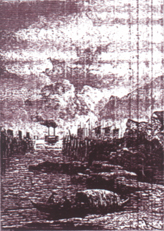Ludovic de Beauvoir was born in Brussels in 1846. His father, the Marquis of Beauvoir, was related by blood to the branch of the Orléans family, overthrown in the 1848 Revolution, to which King Louis XVIII belonged. Barely twenty when he finished his studies, it was decided that Ludovic would join the Duc of Penthièvre (son of the Prince of Joinville and grandson of King Louis XVIII) on a world tour.
Pierre Philippe Jean Marie d'Orléans, Duc of Penthièvre was born in St. Cloud in 1845, and therefore only a few months older than Ludovic de Beauvoir. François Ferdinand d'Orléans, Prince of Joinville, had married Princess Françoise, daughter of the Emperor of Brazil, in 1843. The Duc of Penthièvre was therefore of Portuguese descent on his mother's side and addressed as a "cousin of the King of Portugal".
The two young men left Paris in April, 1866, and visited, in succession, Australia, Java, Siam (Thailand), Hong Kong, Macao and Guangzhou, Northern China, Japan and California, arriving back in France in September, 1867.
In 1869, Ludovic de Beauvoir published two volumes respectively titled Australie (Australia) and Java, Siam, Canton (Java, Siam, Guangzhou) which were widely acclaimed and republished on several occasions. In 1870, Ludovic joined up to serve in the war against Germany and at the beginning of the Third Republic entered the diplomatic corps. In 1876, he became Head of Cabinet at the French Foreign Office, under Duc Decazes. In 1872, he published Pékin, Yeddo, San Francisco (Beijing, Yeddo and San Francisco), the third volume of his travels around the globe, which was also extremely well received by the critics, and for which, all three volumes included, he was awarded a prize by the Académie Française (French Academy).
In 1867, the two young men were welcomed to Macao by the local authorities and the Governor, Dom Joze Maria da Ponte e Horta, who officially placed a gunboat at their service. They visited all the major points of interest in the city, among others the Praya Grande, Mong-Ha 'village', Leal Senado, the forts, the churches and, obviously, the Camões Grotto, where they took some delight in reading the inscription left by the Frenchman Louis Rienzi. But the most astonishing passages of Ludovic de Beauvoir's travel book are those which describe the "Barracons" [sic] (Port.: "Barracões", or "Barracks") where the Chinese coolies were lodged while awaiting transportation to other parts of the world... a shoddy commerce which at the time brought great wealth to the territory, and memories of which are presently silenced.

"Our gunboat zigzaged between the bamboo palissades [...]."
In: BEAUVOIR, Comte [Marquis] Ludovic de, Australie (vol. 1) + Java, Siam, Canton (vol. 2), 2 vols., Paris, 1869, vol. 1, p.580.
* Member of the École des Hautes Études en Sciences Sociales (Higher Institute of Social Sciences) of the Ministère de l'Éducation National (Ministry of Education), Paris.
start p. 101
end p.